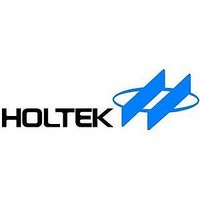HT1381 Holtek, HT1381 Datasheet

HT1381
Available stocks
Related parts for HT1381
HT1381 Summary of contents
Page 1
... A 32768Hz crystal is required to provide the correct timing. In order to minimize the pin number, the HT1380/HT1381 use a se- rial I/O transmission method to interface with a microprocessor. Only three wires are required: (1) REST, (2) SCLK and (3) I/O. Data can be de- livered 1 byte at a time burst bytes ...
Page 2
... Reset pin with serial transmission Data input/output pin with serial transmission Serial clock pulse pin with serial transmission Positive power supply Storage Temperature.................-50°C to 125°C +0.3V Operating Temperature ..................0°C to 70° HT1380/HT1381 Unit 775.00 494.60 -203.90 -618.30 -4.30 332.60 572.60 ...
Page 3
... D.C. 3 HT1380/HT1381 Ta=25°C Max. Unit 5.5 V 100 nA 100 nA 1.0 mA 1.2 mA ¾ mA ¾ ¾ ¾ mA ¾ V 0.8 V ¾ Hz 0.5 MHz 2 MHz Ta=25° ...
Page 4
... Refer to the table shown below and follow the steps to write the data to the chip. First give a Command Byte of HT1380/HT1381, and then write a data in the register. This table illustrates the correlation between Command Byte and their bits: ...
Page 5
... Burst mode When the Command Byte is 10111110 (or 10111111), the HT1380/HT1381 is configured in burst mode. In this mode the eight clock/calen- dar registers can be written (or read) in series, starting with bit 0 of register address 0 (see the timing on the next page) ...
Page 6
... REST remains at high level. Data outputs are read starting with bit 0. Crystal selection A 32768Hz crystal can be directly connected to the HT1380/HT1381 via pin 2 and pin 3 (X1, X2). In order to obtain the correct frequency, two additional load capacities (C1, C2) are needed. The value of the capacity depends on how accurate the crystal is ...
Page 7
... Both input and output data starts with bit 0. In using the HT1380/HT1381, set first the WP and and wait for about 3 seconds, the oscilla- tor will generate the clocks for internal use. Then, choose either single mode or burst mode to input the data ...
Page 8
... Single byte data · · protect (WP=0) bit and transfer enable the oscillator (CH= reading data byte from HT1380/HT1381 register, the first data bit to be transmitted at the first falling edge after the last bit of the command byte is written. HT1380/HT1381 Burst mode data · transfer 8 ...
Page 9
... Timing Diagrams Read data transfer Write data transfer Application Circuits m *Note: The value of the capacity depends on how accurate the crystal is. Refer to the suggestion table of page 7. HT1380/HT1381 9 September 18, 2000 ...
Page 10
... Holtek¢s products are not authorized for use as critical com- ponents in life support devices or systems. Holtek reserves the right to alter its products without prior notification. For the most up-to-date information, please visit our web site at http://www.holtek.com.tw. HT1380/HT1381 10 September 18, 2000 ...











